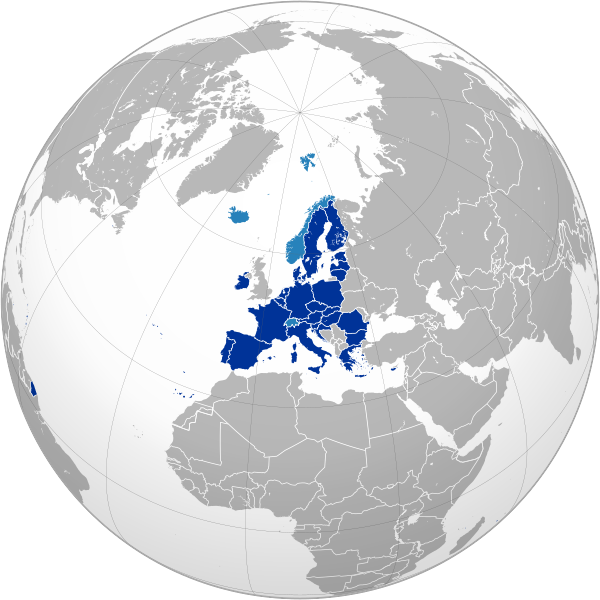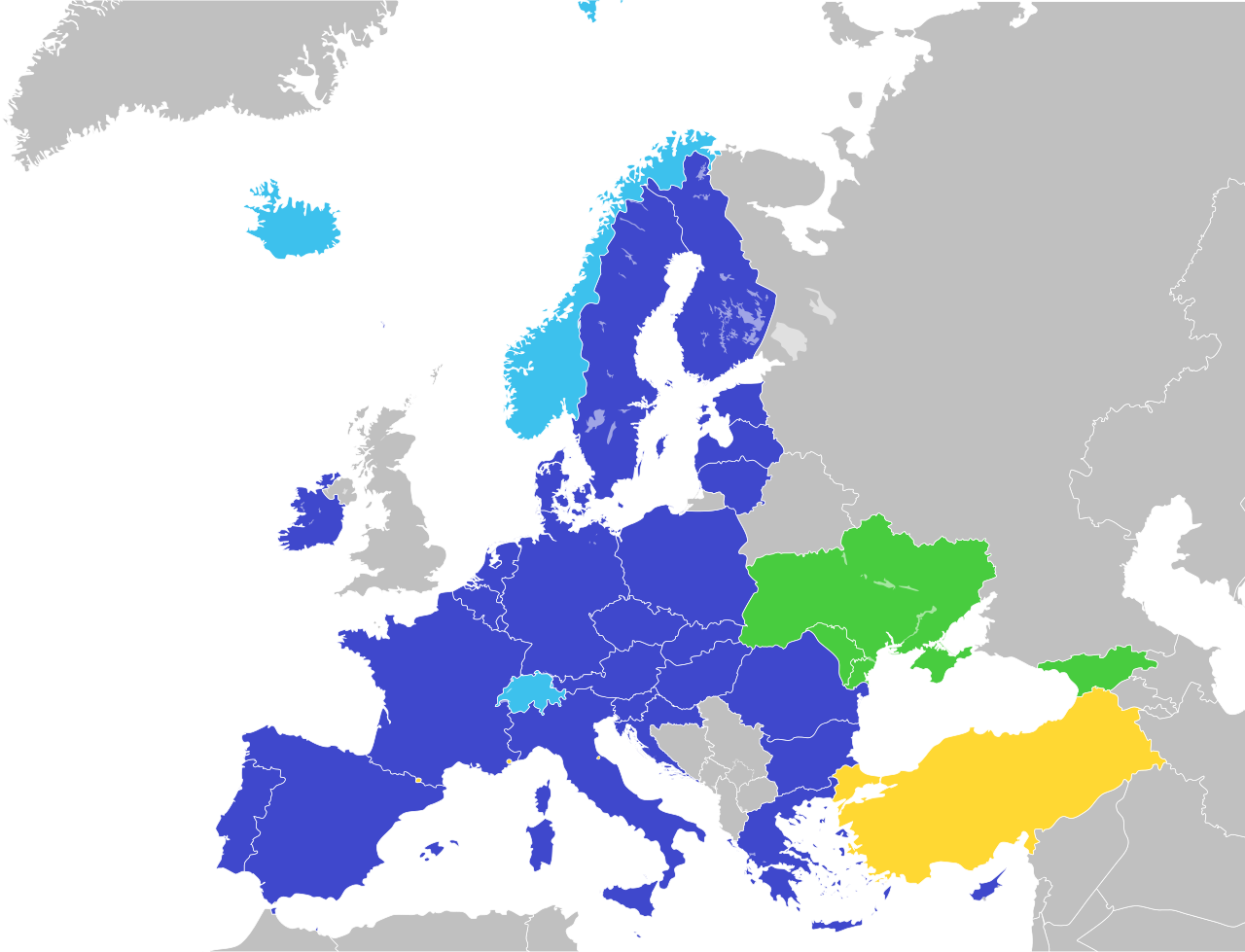AQA Specification focus:
‘The main characteristics of the Single European Market (SEM).’
The Single European Market is a cornerstone of European integration, removing barriers to trade, promoting competition, and facilitating economic growth among member states.
Overview of the Single European Market
The Single European Market (SEM), established in 1993, is one of the most important features of the European Union’s economic framework. Its aim is to create a unified marketplace where goods, services, capital, and labour can move freely between member states, mirroring conditions of a domestic market across Europe. This integration enhances efficiency, expands consumer choice, and strengthens Europe’s position in the global economy.

This map displays the European Single Market's reach, encompassing EU member states and select non-EU countries, underscoring the SEM's extensive integration. Source
Core Characteristics of the SEM
Free Movement of Goods
A defining element of the SEM is the elimination of tariffs and quotas between member states. This allows products manufactured in one EU country to be sold in any other without additional costs or restrictions.
Goods face no customs duties within the SEM.
Non-tariff barriers, such as differing technical standards, are reduced through harmonisation and mutual recognition of regulations.
This reduces transaction costs and promotes specialisation based on comparative advantage.
Comparative Advantage: When a country can produce a good at a lower opportunity cost than another, giving it efficiency in trade.
This principle underpins why trade within the SEM increases total output.
Free Movement of Services
The SEM enables firms and professionals to offer services across borders with minimal restrictions. For example, banks, insurance companies, and consultancies can establish and operate in any member state.
Cross-border provision of financial services, transport, and digital services is permitted.
A level playing field is encouraged by enforcing EU-wide rules on competition, consumer protection, and safety standards.
Free Movement of Capital
The removal of restrictions on capital flows allows funds to move freely across member states.
Investment can flow to where it is most productive.
Individuals and businesses can open bank accounts, purchase property, or invest across borders.
This deepens financial integration and supports economic development.
Capital Mobility: The ability of individuals and firms to move money and financial assets across countries without restriction.
Free Movement of Labour
Labour mobility is a key feature of the SEM, enabling citizens of member states to live, work, and study in other EU countries without restrictions.
Workers have the right to equal treatment in terms of pay, working conditions, and social benefits.
This helps reduce unemployment disparities across regions by reallocating labour where demand is higher.
It also fosters cultural exchange and strengthens the EU’s human capital base.
Competition Policy and Regulation
The SEM enforces a strict competition policy to prevent unfair practices.
Anti-trust laws prohibit monopolies and cartels that could restrict competition.
State aid control prevents governments from distorting the market by favouring domestic industries.
The European Commission plays a central role in regulating competition and ensuring compliance.
Harmonisation and Standardisation
The SEM requires countries to align certain standards and regulations to ensure fair competition.
Common rules cover areas like health and safety, environmental regulations, and product standards.
Harmonisation reduces uncertainty for businesses and ensures consumers across the EU receive consistent quality and protection.
Single Currency Link
While not all members are part of the eurozone, the euro supports the functioning of the SEM by eliminating exchange rate costs and fluctuations within participating countries. This strengthens integration, particularly in financial markets and cross-border trade.
Benefits of the Single European Market
The SEM delivers several key economic benefits:
Economies of scale: Firms can expand production across the EU, reducing average costs.
Increased competition: With easier entry into new markets, firms face stronger competition, improving efficiency and innovation.
Consumer choice: Households enjoy a wider variety of goods and services at competitive prices.
Attraction of investment: The large, unified market attracts foreign direct investment (FDI).

This diagram illustrates the structure of the European Single Market, highlighting the integration of EU member states, EFTA countries, and other nations through various agreements. Source
Foreign Direct Investment (FDI): Investment by a firm or individual in one country into business operations or assets located in another country.
By fostering efficiency and attracting capital, the SEM strengthens Europe’s global competitiveness.
Challenges within the SEM
Despite its advantages, the SEM faces several challenges:
Regulatory divergence: Some national regulations still create barriers.
Labour market frictions: Language and cultural differences can limit mobility.
Uneven benefits: Certain regions or industries benefit more than others, leading to tensions.
Brexit: The UK’s departure from the EU has reshaped trade and labour dynamics, highlighting political and economic complexities.
Key Takeaways for AQA Students
The main characteristics of the Single European Market include:
Free movement of goods, services, capital, and labour.
Common regulatory framework and harmonisation of standards.
Strong competition policy enforced by the European Commission.
Integration supported by the single currency (for eurozone members).
These features underpin the SEM’s role in fostering integration, efficiency, and competitiveness across the European Union.
FAQ
Mutual recognition allows products legally sold in one EU member state to be marketed in another without additional checks or barriers.
This principle reduces duplication of standards, simplifies cross-border trade, and ensures businesses can expand more easily. It complements harmonisation by covering areas where common EU-wide rules do not exist.
The SEM removes protectionist barriers, exposing firms to more competitors across borders.
Firms must innovate to remain competitive.
Prices are kept lower as firms cannot rely on local dominance.
Consumers benefit from higher quality and more diverse products.
The European Commission enforces strict anti-trust rules to prevent anti-competitive behaviour such as cartels or abuse of market power.
The SEM opens access to a much larger customer base without the costs of tariffs or customs checks.
Small and medium-sized enterprises (SMEs) benefit from:
Economies of scale through expanded operations.
Easier access to suppliers across the EU.
Digital and service freedoms, enabling online businesses to reach customers EU-wide.
To ensure labour mobility, professional qualifications in areas such as medicine, law, and engineering are often recognised across member states.
This system reduces barriers for skilled workers moving between countries.
For regulated professions, EU directives set minimum training and qualification standards, ensuring consistency and protecting consumers.
While the European Commission sets and monitors rules, enforcement can vary.
Some countries may interpret regulations differently.
Legal disputes between member states or firms may delay resolution.
Cultural and language barriers sometimes hinder full labour mobility.
These challenges highlight the complexity of maintaining a fully integrated market across diverse economies.
Practice Questions
Identify three key characteristics of the Single European Market (SEM). (3 marks)
1 mark for each correct characteristic identified, up to a maximum of 3 marks.
Acceptable answers include:
Free movement of goods.
Free movement of services.
Free movement of capital.
Free movement of labour.
Harmonisation of regulations/standards.
Enforcement of EU competition policy.
Explain how the Single European Market (SEM) benefits consumers within member states. (6 marks)
1–2 marks: Basic awareness of benefits, e.g. greater consumer choice or lower prices.
3–4 marks: Developed explanation, linking at least two SEM characteristics to consumer outcomes (e.g. free movement of goods leading to greater choice; competition policy reducing prices).
5–6 marks: Clear, well-structured analysis showing depth, possibly with multiple benefits (choice, lower costs, improved quality, innovation) and reference to integration across the EU.

